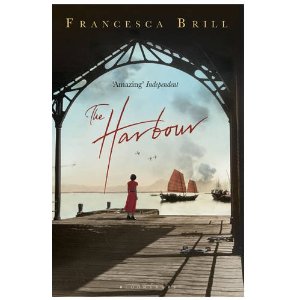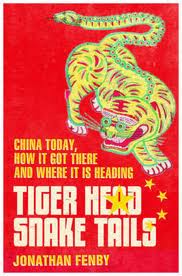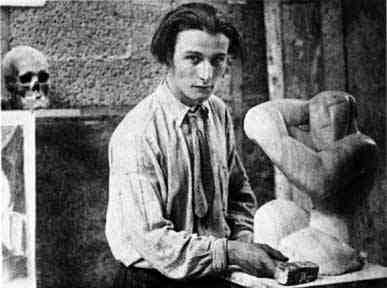Posted: June 4th, 2012 | No Comments »
I’m sure all readers of China Rhyming know the story of Emily Hahn and Charles Boxer and their affair in Hong Kong during the fall of the Colony. I’m equally sure that everyone has an opinion on Miss Hahn – they usually run from the obsessively admiring and ‘she can do no wrong’ to intense dislike. Personally, I veer depending on my mood. The one thing that was probably true about Hahn was that she never boring….
Now a writer called Francesca Brill has reimagined that relationship and the period in Hong Kong in a novel called The Harbour (and thankfully spelt properly too!!)
Blurb, as ever, below and an interview with the author about Hahn etc in Dymocks Hong Kong’s The Booklover newsletter.

Review
A haunting tale of love’s struggle to survive against all odds. A bold and beautifully written debut Mark Mills, author of The Savage Garden Gripping and moving … Francesca Brill is a very good writer indeed and I was sucked into the story until I was no longer aware of things going on around me, only of what was going on to the characters I had grown to love, and an era I knew very little about but which was instantly fascinating. High quality story-telling Simon Sebag Montefiore A fiercely imagined and deeply felt story of complicated wartime love. I could see every scene Rosie Alison, author of The Very Thought of You
Product Description
It is the summer of 1940, and for Stevie Steiber, a young American journalist in Hong Kong, the war raging in Europe is a world away. While longing to be taken seriously as a writer, she keeps her readers informed about society gossip from the Orient, her days at the Happy Valley race-course slipping into dangerous, hedonistic nights. Major Harry Field has been charged by Her Majesty’s Government with investigating suspicious activity inside the colony. He is intrigued by the recent arrival of Jishang, a sophisticated Chinese publisher who owns a controversial political magazine. But it is Stevie, Jishang’s outspoken, beautiful correspondent who really fascinates him. As the decadent British contingent remain oblivious to the cataclysm nearly upon them, the spy and the journalist are obsessively drawn to one another. And when the Japanese army seizes the island, they are faced with terrifying challenges. What will they sacrifice to stay alive, and how far will they go to protect each other? The Harbour is a stunning and utterly compelling debut about war, love and betrayal.
Posted: June 2nd, 2012 | No Comments »
JONATHAN FENBY
on
Tiger Head, Snake Tails: China Today, How it Got There and Where it is Heading
Tuesday 5th June 2012 at 6.30pm
LE SUN CHINE 绅公馆
No. 6, Lane 1220 Huashan Road
上海市长å®åŒºåŽå±±è·¯1220弄6å·

Although Jonathan Fenby does not define himself as a Sinologist, the depth and breadth of his knowledge place him among the best-informed and most interesting writers discussing China today. From his insightful Penguin History of Modern China: The Fall and Rise of a Great Power, 1850-2009, to his comprehensive biography of Chiang Kai-Shek and his latest book Tiger Head, Snake Tails, Fenby has consistently mined the fertile seam of Chinese history, culture and current affairs to craft an opus of perceptive and intelligent books.
With Tiger Head, Snake Tails, Fenby has created the book that every China-watcher dreams of writing. Coming at a time when the Middle Kingdom is at the forefront of world attention for its relentless development and economic clout, the book navigates the physical and metaphysical landscape of modern China, explaining how it got to where it is today in context of its unique and often difficult history. As Julia Lovell wrote in a recent review of the book in The Guardian, Tiger Head, Snake Tails is “a handbook on the confusing state of contemporary China – covering the economic, political, social and historical essentials of the story.â€
China is a nation of superlatives: the biggest, the most, the fastest, the best, the worst. As Fenby writes, “There is not one China but a hundred, a thousand or a million.” So how do we understand a nation of such astonishing breadth, scale and momentum? The book’s title holds clues to the main force behind Fenby’s view of the nation. The phrase 虎头蛇尾 (hÅ tóu shé wÄ•i) invokes the image of a strong, powerful tiger at the helm, and a wake of sly snakes bringing up the rear. With this metaphor, Fenby implies that while China is leading in terms of its economic thrust, it drags a complex and uncontrollable nest of vipers in its wake in the form of corruption, scandal, inequality and environmental degradation. While monetary success may overshadow corruption and incompetence at present, the future is uncertain if the “snake tails†remain unchecked.
Mixing hard facts with intriguing and irresistible vignettes about the state of the nation – such as the railway minister with 18 mistresses, the local government in which female civil servants had to have “symmetrical breasts†– Fenby has crafted an eminently readable work.
The body of the book covers the expansion of the transport network and infrastructure that has led to the logistical unification of China, and the growth of cities that has spurred vast economic growth. Fenby discusses poor working conditions, the conflict between the centre and the provinces, scandal and corruption, and unrest between the Han majority and the autonomous ethnic groups. He looks to Hong Kong and Taiwan to provide alternative paradigms as to how China might have been under different politics systems, and postulates how China will progress. His decision not to touch on the potentially intriguing issue of culture and soft power is regrettable, but understandable given the scope of possible subject matter at hand.
In a review of the book for the Financial Times, former Hong Kong Governor Chris Patten writes that “both Sino-enthusiasts and Sino-doom-mongers will find much in this book to confirm their prejudicesâ€, a parallel that surely speaks of Fenby’s success in offering a balanced view. The book is, according to Julia Lovell, “…a one-stop guide to political and economic realities in China today, Tiger Head, Snake Tails is fast-moving, informed and illuminating.â€
In his biography of Chiang Kai-Shek, Fenby exercises similar restraint, choosing to focus on the Generalissimo’s thorny relationship with US general Joseph Stilwell (whom Roosevelt had assigned to support China’s Nationalist government, which had retreated from the Japanese to the far west of China), the unpalatable details of his dealings with the women in his life, and the thorny political landscape of China in the early 20th century. Covering the loss of Shanghai, Nanjing and Wuhan, Song Meiling’s triumphal tour of the US, the loss of the Civil War and the retreat to Taiwan, the book does little to resuscitate Chiang’s reputation among China’s leading political luminaries. However, it presents a graphic and honest picture of the man who
While Tiger Head, Snake Tails presents a wide view of modern China in context of its history, Generalissimo is a crystallization, charting a period when the nation was in flux. Read side by side, the two works present a simultaneous microcosm and macrocosm from which we can learn much. In the words of British commentator Will Hutton in a recent review in the Observer, it is “timely and brilliant [with] superb analysisâ€.
About the Author
Jonathan Fenby, CBE, is the author of many books including a biography of Chiang Kai-Shek and The Penguin History of Modern China: The Fall and Rise of a Great Power, 1850-2009. He speaks at conferences, universities and public forums on China, and has written widely about the nation’s history and politics.
As a journalist, Fenby was editor of The Observer newspaper from 1993 to 1995, then editor of the South China Morning Post between 1995 and 2000, spanning the return of Hong Kong to Chinese sovereignty. His previous positions included Deputy Editor of The Guardian, Home Editor of The Independent, and Editor of Reuters World Service. He was chief correspondent for The Economist in France and Germany from 1981 to 1986.
Fenby published ten books between 1998 and 2008 – five on China and rest on the Second World War and France. He contributes to a wide range of publications in the UK, US and Far East, and is currently Director of China Research at the research service Trusted Sources.
Entrance: RMB 80 (RAS members) and RMB 130 (non-members). Ticket price includes a drink (soft, tea, coffee or glass of wine). Those unable to make the donation but wishing to attend may contact us for part exemption prior to the RAS Lecture. Membership applications and membership renewals will be available at this event.
RSVP: to RAS Bookings at: bookings@royalasiaticsociety.org.cn
N.B. Reservations are essential for this event as places are limited. RAS members have priority until Friday 1st June, 2012.
BOOK AVAILABILITY
Copies of Fenby’s latest book, Tiger Head, Snake Tails: China Today, How it Got There and Where it is Heading will be available at the event. In order to ensure that everyone who wants to buy the book is covered in our pre-order numbers, please let us know in advance if you would like to purchase it at the price of RMB 190.
Posted: June 2nd, 2012 | No Comments »

Found myself the other day watching the 1935 movie Charlie Chan in Shanghai. All the usual Charlie Chan fun and games with Warner Oland in “yellow face”, broken English and Keye Luke as Number One Son and all that….Of course the movies were made in Hollywood on sets but occasionally interesting sets that replicated (perhaps) real locations were built and sometimes real shots were inserted for effect. And so following in the next couple of posts a few examples…
When Charlie arrives in Shanghai we suddenly shoot from a rather obvious stage set of the passenger ship to a shot of the real landing stage at Shanghai in the 1930s. You can see the majestic sweep of the Bund with all its landmarks – Customs House, Cathay Hotel etc etc, as well as the landing stage where passengers were offloaded, surrounded by sampans. Great shot…

Posted: June 1st, 2012 | No Comments »
Fantastic to see that Graham Hodges’s biography of Anna May Wong is being reissued by Hong Kong University Press (and I understand there’s a Chinese language edition coming for the first time too later in the year). I note that the amazing Anna May Wong film she made in London in 1929 Piccadilly is still around on DVD and on iTunes – if you’ve never seen it then do. A clip from YouTube here. Anyway, here’s the details of the book…
Anna May Wong
From Laundryman’s Daughter to Hollywood Legend
Graham Russell Gao Hodges

Anna May Wong was the best known Chinese American actress during Hollywood’s golden age, a free spirit and embodiment of the flapper era much like Louise Brooks. She starred in over fifty movies between 1919 and 1960, sharing the screen with such luminaries as Douglas Fairbanks Sr. and Marlene Dietrich.Born in Los Angeles in 1905, Wong was the second daughter of six children born to a laundryman and his wife. Obsessed with film at a young age, she managed to secure a small part in a 1919 drama about the Boxer Rebellion. Her most famous fi lm roles were in
The Thief of Baghdad, Old San Francisco, and
Shanghai Express opposite Dietrich. Despite these successes, instances of overt racism plagued Wong’s career. When it came time to make a film version of Pearl Buck’s
The Good Earth, she was passed over for the German actress, Luise Rainer. In a narrative that recalls both the gritty life in Los Angeles’ working-class Chinese neighborhoods and the glamor of Hollywood at its peak, Graham Hodges recounts the life of this elegant, beautiful, and underappreciated screen legend.
Graham Russell Gao Hodges is the George Dorland Langdon, Jr. Professor of History and Africana Studies at Colgate University.
“An illuminating, authoritative biography of Anna May Wong—one of the most enigmatic icons in Hollywood and in the history of Chinese America.” — Yunte Huang, author of Charlie Chan: The Untold Story of the Honorable Detective and His Rendezvous with American History
“Through a scrupulous examination of Anna May Wong’s life and work, Graham Russell Gao Hodges, a leading African American historian, deploys his keen understanding of American racial matters to transform Wong from merely a tragic figure to a real human being, vulnerable, and longing for appreciation, love and family. The Anna May Wong that comes to life in this definitive biography is admirable because of her honesty, hard work, and true dedication to her craft as an actress, despite repeated denials of opportunities and deserved recognition—due to her race. Her courage and humanity are a lesson to all who strive for a harmonious and just multiracial society.” — Peter Kwong, City University of New York, and author of Chinese America: The Untold Story of America’s Oldest New Community
“Graham Russell Gao Hodges’ fascinating biography of Anna May Wong is an important contribution to not only film studies but Asian American history and women’s history. The facts of Wong’s life—her humble origins as laundryman’s daughter, her tragic love affairs, her international political activism, and her celebrity status as the nation’s first Chinese American movie star—are far more compelling than any of her roles on film.” — Iris Chang, author of The Rape of Nanking: The Forgotten Holocaust of World War II and The Chinese in America: A Narrative History
“Graham Hodges has woven a spellbinding tale that sweeps you into Anna May Wong’s star-crossed life, with rich details of the passions and lost loves, conflicts and triumphs, brilliance and frustrations of this daring woman born far ahead of her time. Like a scene with the great diva, this book has nuance, complexity, and drama—and I did not want it to end.” — Helen Zia, author of Asian American Dreams: The Emergence of an American People
Posted: May 31st, 2012 | No Comments »
From Ezra Pound and 1915. This is a translation of an old Chinese poem about men on the front line facing the Mongols. He obviously saw links with the trenches of World War One. Pound adapted the traditional Chinese poem and sent it to the French sculptor Henri Gaudier-Brzeska, who Pound massively admired but who died at the Front in 1915. He wrote to Pound that he saw the resonances between the Chinese bowmen on the Great Wall watching and waiting for the Mongol attacks and his own position sitting in a trench waiting for the inevitable German onslaught. Pound recognised Gaudier-Brzeska’s talent and so mourned his loss while celebrating him as a inspiration for Vorticism. And so here is The Song of the Bowmen of Shu by Pound but with a picture of the muse for the piece Gaudier-Brzeska.

Here we are, picking the first fern-shoots
And saying: When shall we get back to our country?
Here we are because we have the Ken-nin for our foemen,
We have no comfort because of these Mongols.
We grub the soft fern-shoots,
When anyone says “Return,â€Â the others are full of sorrow.
Sorrowful minds, sorrow is strong, we are hungry and thirsty.
Our defence is not yet made sure, no one can let his friend return.
We grub the old fern-stalks.
We say: Will we be let to go back in October?
There is no ease in royal affairs, we have no comfort.
Our sorrow is bitter, but we would not return to our country.
What flower has come into blossom?
Whose chariot? The General’s.
Horses, his horses even, are tired. They were strong.
We have no rest, three battles a month.
By heaven, his horses are tired.
The generals are on them, the soldiers are by them.
The horses are well trained,
the generals have ivory arrows and quivers ornamented with fish-skin.
The enemy is swift, we must be careful.
When we set out, the willows were drooping with spring,
We come back in the snow,
We go slowly, we are hungry and thirsty,
Our mind is full of sorrow, who will know of our grief?










